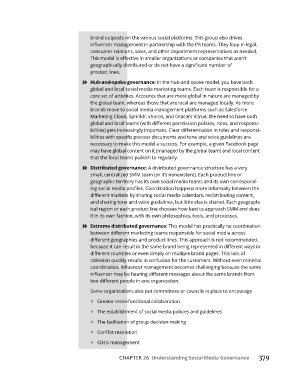Page 395 - Social Media Marketing for Dummies
P. 395
brand outposts on the various social platforms. This group also drives
influencer management in partnership with the PR teams. They loop in legal,
consumer relations, sales, and other department representatives as needed.
This model is effective in smaller organizations or companies that aren’t
geographically distributed or do not have a significant number of
product lines.
» Hub-and-spoke governance: In the hub-and-spoke model, you have both
global and local social media marketing teams. Each team is responsible for a
core set of activities. Accounts that are more global in nature are managed by
the global team, whereas those that are local are managed locally. As more
brands move to social media management platforms such as Salesforce
Marketing Cloud, Sprinklr, khoros, and Oracle’s Vitrue, the need to have both
global and local teams (with different permission policies, roles, and responsi-
bilities) gets increasingly important. Clear differentiation in roles and responsi-
bilities with specific process documents and tone and voice guidelines are
necessary to make this model a success. For example, a given Facebook page
may have global content on it (managed by the global team) and local content
that the local teams publish to regularly.
» Distributed governance: A distributed governance structure has a very
small, centralized SMM team (or it’s nonexistent). Each product line or
geographic territory has its own social media teams and its own correspond-
ing social media profiles. Coordination happens more informally between the
different markets by sharing social media calendars, redistributing content,
and sharing tone and voice guidelines, but little else is shared. Each geograph-
ical region or each product line chooses how best to approach SMM and does
it in its own fashion, with its own philosophies, tools, and processes.
» Extreme distributed governance: This model has practically no coordination
between different marketing teams responsible for social media across
different geographies and product lines. This approach is not recommended,
because it can result in the same brand being represented in different ways in
different countries or even simply on multiple brand pages. This lack of
cohesion quickly results in confusion for the customers. Without even minimal
coordination, influencer management becomes challenging because the same
influencer may be hearing different messages about the same brands from
two different people in one organization.
Some organizations also put committees or councils in place to encourage
• Greater cross-functional collaboration
• The establishment of social media policies and guidelines
• The facilitation of group decision-making
• Conflict resolution
• Crisis management
CHAPTER 26 Understanding Social Media Governance 379

